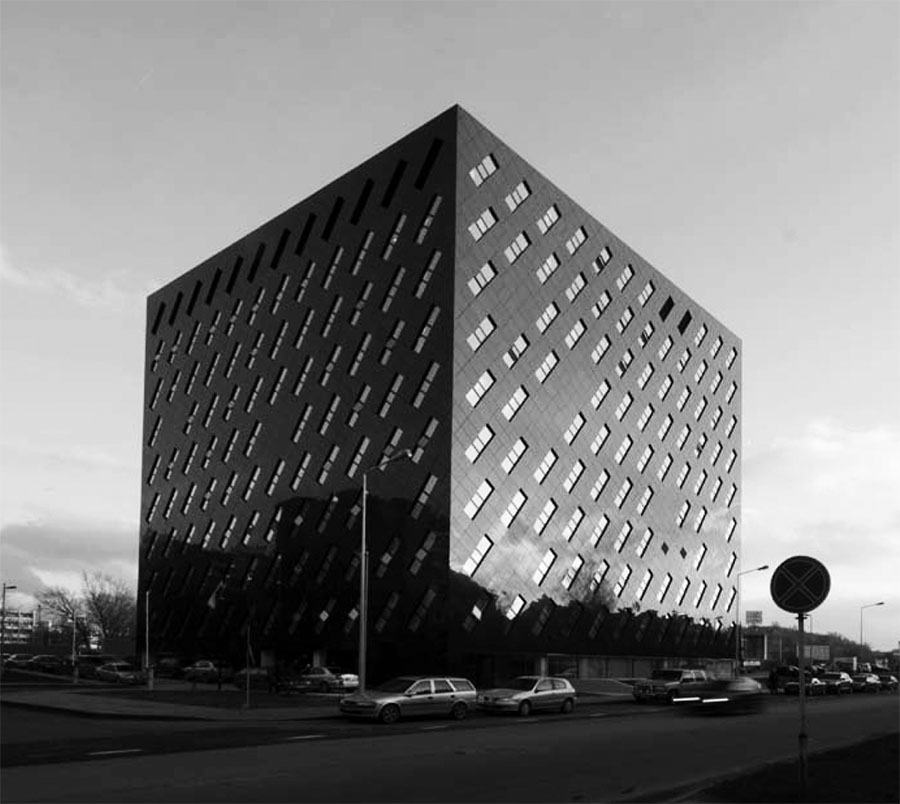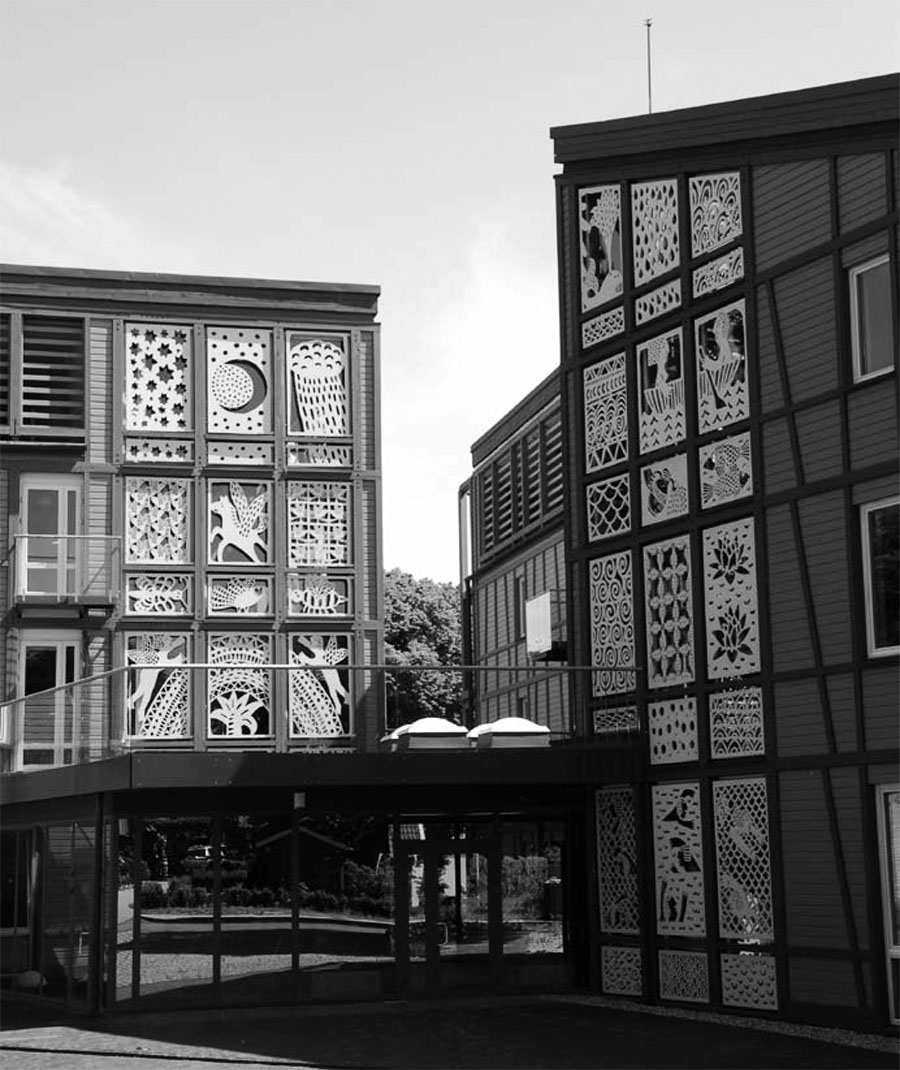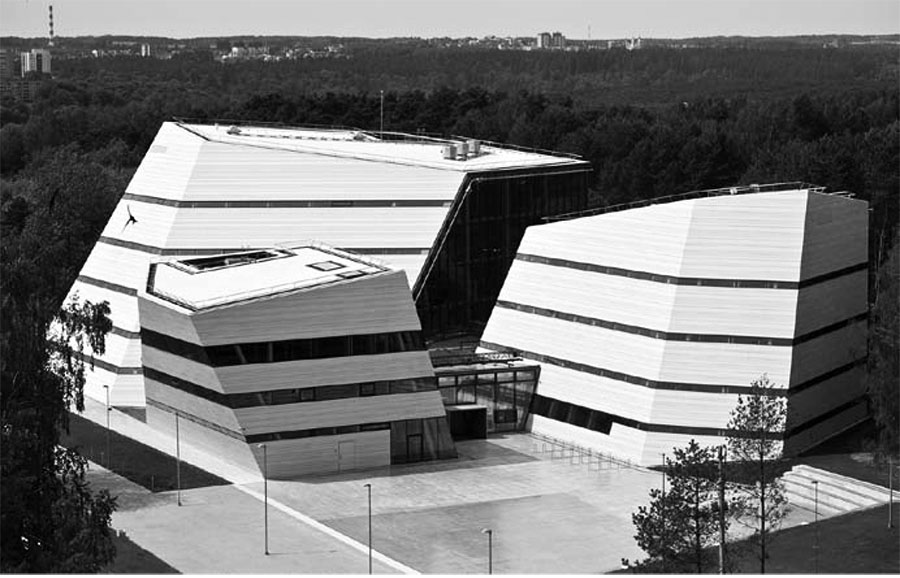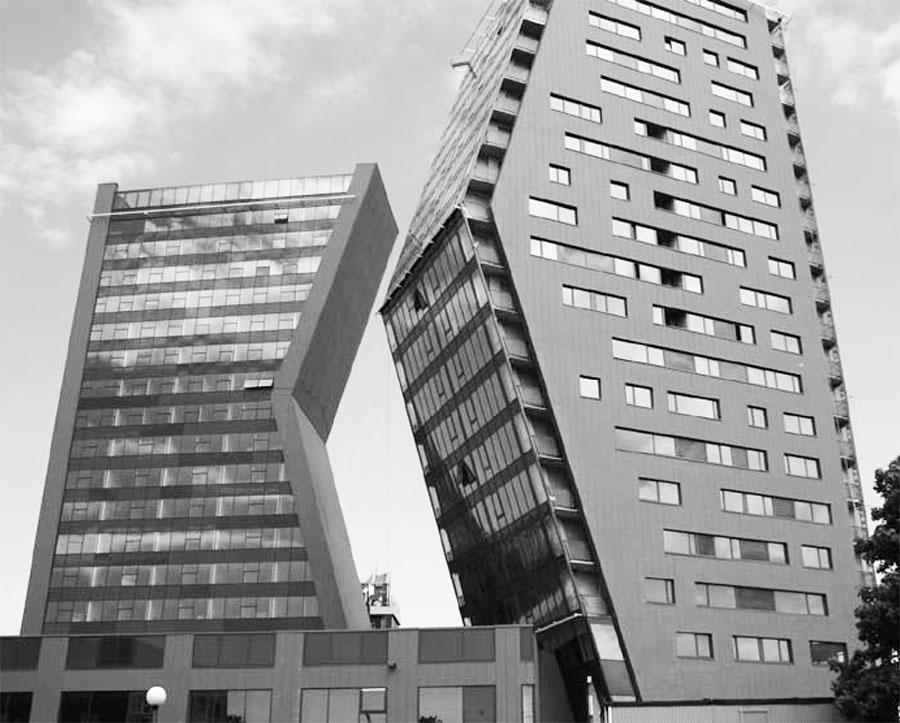
Copyright © 2015 LITUANUS Foundation, Inc.
Editor of this issue: Almantas Samalavičius
 LITHUANIAN
QUARTERLY JOURNAL OF ARTS AND SCIENCES
|
ISSN
0024-5089
Copyright © 2015 LITUANUS Foundation, Inc. |
|
Volume
61, No.1 - Spring 2015
Editor of this issue: Almantas Samalavičius |
The Spread of Design Movements in Contemporary Lithuanian Architecture
RIMANTAS BUIVYDAS
RIMANTAS BUIVYDAS is a professor at Vilniuss Gediminas Technical University with a doctorate in art history. He is the author of four scholarly monographs and collections of articles. His interests include contemporary Lithuanian architecture, architectural symbols, problems of advanced studies in architecture, and the interaction of architecture and art in theory and practice.
Abstract
This
article surveys the changes in the architecture of Lithuania since it
gained independence, specifically in regard to the spread and adoption
of various architectural styles. In a relatively short period in a
rather small country, many different realizations of architectural
concepts and trends have been achieved.
The years of change after Lithuania gained its independence
affected all spheres of culture in a profound way. During the
last twenty years, the winds of change have suffused the art of
architecture as well. The new phenomena that have appeared
in Lithuanian architecture reflect the radical changes in our
countrys political, economic, and cultural life. New typologies
in architecture have sprung up, the functional texture
of many structures has changed, new construction systems
and materials have begun to be widely used, and architects
have started to turn more attention to preservation, ecological
conservation, and the social significance of architectural development.
The general democratization of the countrys life
and its active integration into the world of Western culture,
forbidden during the Soviet years, effected serious revisions
in the consciousness of the architectural profession. All of
this means the creative tendencies and variety of artistic endeavor
that appeared after independence can be appreciated as a distinct innovation. At the same time, it is imperative to
keep in mind that design expression in Lithuanian architecture
is not an absolute innovation at the level of ideological
conception. In essence, the expansion of todays architectural
movements aims to adapt our practice to directions developed
abroad. This insight should not be judged a negative
characteristic or an expression of some shortcoming in Lithuanian
architecture. After all, dangerous isolation or attaching
too much significance to a pathology is to be avoided; in attempting
to approach the level of Western architectures art,
the need to experiment with ideas current in other countries,
in both a theoretical and practical sense, simply becomes an
unavoidable necessity. The aim of this article is to reveal why
the spread of Western design movements in contemporary
Lithuanian architecture is occurring and which of them have
inspired well-regarded results.
From the Restrictions that Were to the Torrent of Todays Movements
During the 1990s, the fifty-year period of Soviet rule came to an end. In architecture, as in other artistic fields, the opportunity arose to execute the new artistic concepts proliferating in the West. Nevertheless, it must be noted that, in the architecture of the Soviet period, individual projects in which reflections of the newest foreign movements could be seen, although very few, did appear on occasion. Usually, the ideologues of the Communist Party would severely condemn these cases as an expression of rotten capitalism, alien to Soviet man. At that time, Lithuanian architects were taught Western art concepts in a spirit of jingoistic socialism. Although our examples of new architecture were judged rather highly among Lithuanias professional architects, and a sizable portion of themif only fragmentarily, because of the total information censorship instituted by the systemknew of the advanced directions of foreign architecture, it was forbidden to voice agreement with these concepts in any public forum. It was all the more impossible to declare that an architect consciously followed the essence of one or another Western aesthetic movement. The state morbidly ignored the new vitality of Western architecture. Essentially, during the Soviet years, only the works of foreign architects who had belonged to their countrys Communist Party were openly presented. Probably only professor Jonas Minkevičius, in a book that was very well-regarded by our architects and for many became the equivalent of the knowledge of the forbidden fruit, presented what was going on in architecture elsewhere, even if in a rather brief volume.1
In todays Lithuania, the younger generation of architects finds it difficult to imagine the dearth of information that impoverished the profession during the Soviet years, which manifested itself, not just in the mass media, but in the fact that an architects ability to see new foreign architecture in situ, with their own eyes, was uncommonly difficult. These restrictions were political instruments meant to guarantee the goal that the Soviet Union must have only contemporary Soviet architecture, without any foreign isms. In reality, such prohibitions merely increased the hunger to know, to see, and to try advanced ideas in our architecture. This situation became one more reason why the bubble of ignoring foreign avant-garde ideas burst so suddenly after independence was regained. At the same time, it explains why many of our architects, as if intoxicated with ideological and informational freedom, began to use such a variety of creative concepts. Incidentally, this untrammeled enthusiasm did not always result in designs of good aesthetic quality.
The obvious changes in artistic expression in contemporary Lithuanian architecture are not only determined by an essential change in the life of the country, but also this changes unavoidable transformation of the internal process of planning a project. It is clear the architect has gained more independence and rights, but at the same time, his degree of responsibility has also grown immeasurably. During the Soviet years, most Lithuanian architects worked as rank-and-file employees at large state planning institutes or departmental planning offices. It should be noted that many worked at one or another specialty. They had to work within the irrational bureaucrac characteristic of that period, the teaching and the distorted collectivism of the party nomenklatura, and the frequent imposition of codesigners. Projects usually took a long time to prepare and a large portion were never built, but no one was obliged to answer for this. All of this, as unfavorable as it was to architectural work, was an unavoidable reality.2 Today, architects in Lithuania most often work in private architectural firms, usually with a small number of colleagues. There is hope that this circumstance, together with the freedom to seek creativity, a more harmonious work atmosphere, and the expression of competition explains why projects by the same authors so frequently exhibit a completely different design language. This is often affected by the desire to avoid repetition in the look of buildings.
Typifying the Traits of Architectural Movements
The complex many-sidedness of contemporary Lithuanian architectural design would be worth classifying on the basis of conceptual uniqueness, once the various manifestations are generalized and thoroughly differentiated. This article does not intend to establish the quantity, importance, or standing of these movements in any precise or strict way. At a very basic level, the natural principle of variety in the world affirms everythings interdependence; it is only natural that the aesthetic concepts of architecture are objects of an analogous structure.
Following a similar point of view, we discover that half of contemporary Lithuanian architecture is made up of a movement whose conceptual contents most important signs are objectivity, practicality, social consciousness, and architectural totality. The academic basis of everything and the domination of intellect affirms this segment of architecture as the embodiment of consistent objective factors. These distinctive factors, interpreted by planners, imbue the existence of the segment of architecture alluded to, and in a certain sense, direct it toward an antitraditional reference point. All possible advantages and disadvantages are, to all appearances, set unconditionally and accurately. A similar thought process, as if of its own accord, insists the architect be understood as the equivalent of a perfect and unerring instrument.
At this point, attention must be turned to a specific difference among those architects, recognized in this segment of architectural trends, in their conception of themselves. One school of thought affirms the architect is an omnipotent tactician and strategist, the leader of the architecture-construction process, a strict reformer, and an active fighter for this architectures ideals. A slightly different professional view marks the contours of yet another conceptionthe architect is understood as a mere executor of specific obligations, who does not have an actual or essential influence on the architectural process. This thinking seems to indicate the architect is naturally released from the responsibility and necessity to be a creator, because, in this case, the public and the system will be given the kind of architecture they are capable of commissioning.
In order for the polarization of trends in contemporary Lithuanian architecture to acquire a more obvious character, we will briefly present the segment of architecture described by Charles Jencks as New Modernism, and the artistic movements ascribed to it, with representative examples.3
Which architectural trend should be described first is not particularly important in the Lithuanian context, because, in todays practice, the goals of functionalism, rationalism, and economics continue to rule as a confirmation of the vitality of the architectural ideology that dominated the twentieth century: neomoderism is considered the most popular movement. One of the newest examples in this direction is the 2011 Balsių Middle School in Vilnius (architects: Sigitas Kuncevičius, Martynas Dagys, Loreta Kuncevičienė, Žygimantas Gudelis, Viltė Jurgaitienė, and Aistė Kuncevičiūtė). This project has earned several awards. A number of our recent buildings and urban projects must be regarded as instances of structuralisms architectural concepts. An influential object representing this movement is the residential complex Fredos miestelis (Algimantas Kančas, Laimis Savickas, and Lina Kazakevičiūtė). It should be noted that the conceptual rules are the assertion, typical of structuralism, of the equivalence of interior-exterior and home-city, and the entire complexs modularity of structure and clarity.4 In the Lithuanian context, bold com- positional expression, emotional tension, and a connection with the deconstructivist expressionist movement is marked by the Vilnius University Librarys Academic Communication and Information Center (2012, Rolandas Palekas, Bartas Puzonas, Alma Palekienė, Petras Išora, Matas Šiupšinskas, Monika Zemlickaitė, Lina Sužiedelytė, Aidas Barzda, Jurga Garšvaitė, and Vilmantas Bavarskis). Efforts to express the style of new design through the imagery of industrial manufacturing, carrying over into architecture a sufficiently diffuse computer technology form, would include works attributed to the techno movement. Suitable examples in this direction are two office buildings in Klaipėda (2005, M. and Audrius Bučas). The goals of progress in science and technology and the human penetration of the cosmos have frequently been interpreted in architecture abroad. Although there are not many structures in Lithuania that affirm a futuristic concept in this way, their scarcity merely strengthens the impression made by the Lithuanian Ethnocosmology Center in the Molėtai District (2008, Ričardas Krištopavičius and Audrius Gudaitis). A number of the newest architectural works represent the minimalist movement. According to the Lithuanian minimalist ideologue Kęstutis Lupeikis, the goals of emptiness, silence, simplicity, and purity, offered through new means, inspire todays architects.5 It naturally follows that this architects 2008 design of the Prosecutors Administration Building in Vilnius is a compelling representation of this trend.
 |
| General Prosecutors Office. Vilnius, 2006. Architect: Kęstutis Lupeikis. Photo provided by the acourtesy of the author. |
In the wing of contemporary architecture that is, in a conceptual sense, seemingly in polar opposition to the movements mentioned above, the goals of traditionalism, the affirmation of subjectivity, creative freedom, tolerant universality, flexible views of the regulations of standards and economics, and treatments sensitive to a projects setting are conceptualized. This architectural trend, in which at least several concepts thrive, fosters an identity of place and a radical emotiveness, with signs of subjectivity and attention to the values of traditional architecture. Here, retrospection, eclecticism, alogicality, elementalism, and ephemerality express themselves in various shapes and combinations. Probably the most essential signs assigned to this part of the architectural movement are, on the one hand, an orientation towards the principle of postmodern historical repetition and, on the other, an attempt to create everything as a surprise. In todays Lithuanian architecture, the idea of the context of place has marked weight; one of its clearest realizations is the G. Petkevičaitė-Bitė Public Library in Panevėžys (2006, Saulius Jukšys). A discussion of the vitality of the interpretative historicism movement could explain the clear desire to return the once-lost supposed picturesque in buildings and to respect it in city spaces. A characteristic example of this approach is the group of buildings on Maironis Street in Vilnius (2001, Henrikas Štaudė and Jurgis Leskevičius). A number of these structures express the architectural concepts of symbolism and picturesque metaphor as an antithesis to the expressionlessness that dominated architecture during the Soviet years. Distinctive realizations of these concepts are the two multifunctional buildings in Klaipėda portraying the letters K and D (2007, Edgaras Neniškas and the Arches firm). Displays of postmodernisms retrospective movement have lessened considerably in the last few years. Many architectural projects were devoted to this movement at the beginning of the post-Soviet period. The clearest example, in which resoundsas the professional press writesthe rusty plinth, columns between windows, the accented compositional axis of the central facade, and emphatic cornices,6 is the Hermis 6 Mačiulytė, Bankas Hermis. Bank Building (now SE B) in Vilnius (1996, Kęstutis Pempė and Gytis Ramunis). Among Lithuanian architects, regionalism received special attention. Although traditionalism, ethnoculture, and an understanding of the local spirit vary a great deal in the consciousness of different designers, they are unified in their attempts to foster Lithuanias architectural identity. A good example of these efforts is the villa on Miškas Street in Juodkrantė (2008, Gintaras Prikockis, Asta Prikockienė, Inga Tikuišytė, and Andrius Velutis).
 |
| Villa in Juodkrantė. Architects: Gintaras Prikockis, et al. Photo provided by the courtesy of the author. |
 |
| The Vilnius University Library Academic Communication and Information Center, Vilnius, 2012. Photo by Raimondas Urbakavičius. |
 |
| The multifunctional building group, K and D, in Klaipėda. (Photo courtesy UAB Arches). |
Reconstructions of the units of a specific localitys architectural environment, their spontaneous changes at various times, and their random forms, along with the objective to organically link a new work into its surroundings, inspires the followers of the ad hoc movement. An influential realization of this idea in architecture is the multiunit residential building on Vytautas Street in Vilnius (2000, Romanas Mankus, Robertas Malavickas, Vaidas Saveikis, and Algimantas Šarauskas).
It is natural that, between the two different architectural ideologies discussed here, between poles of opposing artistic conceptions, there is a mixture of styles. The purpose of this article is not to make a precise inventory of all the trends, but to point out that, in a relatively short period of time and in a rather small country, many different realizations of architectural concepts and movements have been accomplished. It is possible that the abundance of movements today, still in the process of evolution, will change into a more consolidated, conceptually mature, and original conception of art.
Notes:
1 Minkevičius, Architektūros kryptys užsienyje.
2 Buivydas, Kai kas apie dvidešimties metų architektūrą.
3 Jencks, The New Moderns.
4 Buivydas, Architektūriniai struktūralizmo idėjos reflektai.
17
5 Lupeikis, Minimalizmo galia.
6 Mačiulytė, Bankas Hermis.
WORKS CITED
Minkevičius, Jonas. Architektūros kryptys užsienyje. Vilnius: Mintis, 1971.
Buivydas, Rimantas. Kai kas apie dvidešimt metų architektūrą, in Laivės architektūra, eds. Tomas Grunskis and Julija Reklaitė. Vilnius: Baltos lankos, 2012.
Jencks, Charles. The New Moderns: From Late to Neo-modernism. New York: Rizzoli, 1990.
Buivydas, Rimantas. Architektūriniai struktūralizmo idėjos reflektai, Urbanistika ir architektūra. 28 (2), 2004.
Lupeikis, Kęstutis. Minimalizmo galia. Vilnius: Technika, 2007.
Mačiulytė, Vilija. Bankas Hermis,
Archiforma.
2, 1996.
t